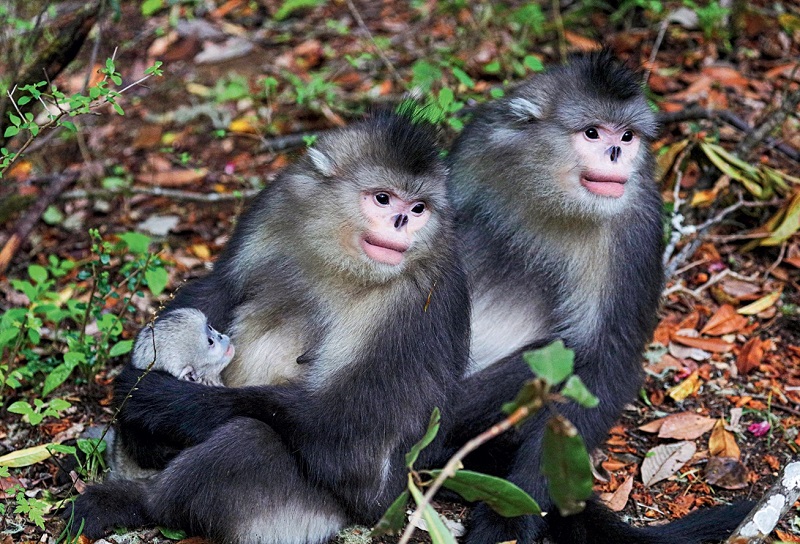
Yunnan golden-hair monkeys photographed by Li Fuhui.
Li Fuhui has a deep emotional connection with the “Snow Mountain genie,” a moniker of the snub-nosed monkey, a rare and endangered primate unique to China. His lens has captured countless extraordinary moments of the species, also known as the Yunnan golden hair monkey, in their daily lives in the Baima Snow Mountain National Nature Reserve in Yunnan Province in the southwest.
The nature reserve is the main habitat of the animal which is found only in the high-altitude regions at the border of Yunnan and Xizang Autonomous Region. The black-and-white monkey is highly sensitive to environmental changes and even minor ecological disturbances pose a significant challenge to its survival. In 1989, it was classified as a national first-class protected wild animal in China.
The reserve is home to 2,500 snub-nosed monkeys, about 65 percent of their entire population in China. The monkeys live in the region’s pristine forests. However, with climate change impacting their habitat as well, their living space is shrinking.
Li has taken nearly 20,000 photographs of the rare monkeys. His first encounter with them was nothing like what he had imagined. “I thought they would be golden, as their name suggests. But when I saw my first one on the Baima Snow Mountain, I was surprised to find its fur was black and white. I asked the head of the local protection station, and he confirmed that this was its natural color,” Li said. “It has an eye-catching tuft of hair on its head, thick red lips, and an upturned nose.” To Li, the snub-nosed monkey is incredibly unique and beautiful.
Records to Raise Awareness
Soon after that fateful encounter, Li dedicated his time and attention to photographing the monkey, capturing it across different seasons. In spring, he documented young monkeys playing with their peers, a mix of liveliness and cuteness. In winter, he captured the monkeys amidst snow, and the scene looked like a traditional Chinese painting.
While photographing in the mountains, Li lived like the forest rangers, and fostered mutual understanding and a special bond with them. The rangers, familiar with the monkeys’ habits, know how not to alarm them, and helped Li observe and photograph the groups up close, capturing stunning images.
For instance, they would scatter pumpkin seeds under the trees where the monkeys rested. When the monkeys awoke and came down to forage, Li would seize the opportunity to take close-ups. These photos are valuable resources for the research and conservation of the Yunnan snub-nosed monkey. Li donated over 5,000 photos taken during his first month at the Baima Snow Mountain to the reserve’s management bureau.
He finds many similarities between the monkeys and humans. “The monkeys live in families. At first glance, they may seem just a group of monkeys. But if you observe closely, you’ll see they have their own social rhythm, emotions, and intelligence,” he explained. He hopes that through his photography, more people will come to know about the snub-nosed monkey and appreciate it, resulting in public awareness about the need to protect rare species.

He Xinming during a field trip in the mountains.
“Resilience of Life”
The golden-hair genies have other guardians like Li. He Xinming, a senior engineer at the Ecology Research Institute of the reserve, is one of them. For two decades, he has been working on conservation of the Yunnan snub-nosed monkey, in the process forging a deep bond with them.
He spent 2007 and 2008 tracking the monkeys in the wild. “I spent about 300 days each year in the mountains, following the monkeys wherever they went,” he said. “Sometimes, our campsite would be just a few hundred meters from them.” He gained deep insights into the monkeys’ social structure, ecological behavior, and dietary habits.
In 2008, the reserve established a wildlife rescue station and he was appointed its head. Short-staffed, they were on duty 24 hours; the hardship was rewarded in 2019, when they rescued a one-month-old snub-nosed monkey and it survived, thanks to their meticulous care. It was their first successful rescue of a wild baby monkey. “In this little monkey, I saw the resilience of life, which deepened my affection for the Yunnan snub-nosed monkey,” He said emotionally.
He also participated in two surveys on the Yunnan snub-nosed monkey populations in 2004 and 2017. During the 2017-2018 survey, he led his team to 10 different locations, identifying nine monkey groups, including three new populations in the Lancang River Basin. This discovery filled a gap in baseline data for the Yunnan snub-nosed monkey populations in the region, providing valuable references for future research and conservation efforts. 